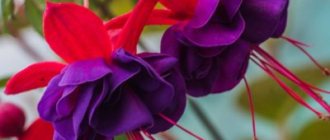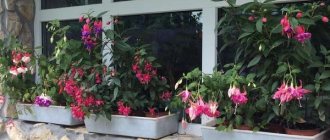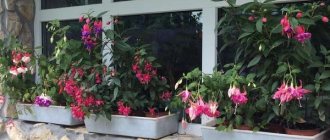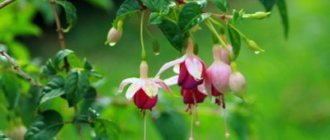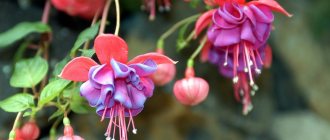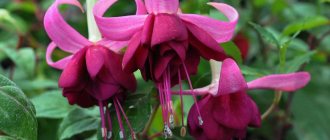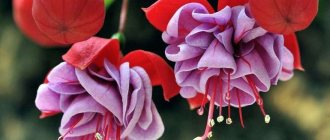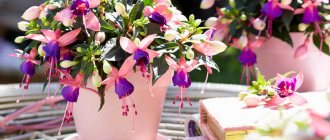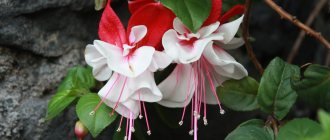Description
Fuchsia is a perennial plant of the Fireweed family. Thanks to the numerous variety of ornamental varieties with unusual bright colors, this tenacious evergreen flower has deservedly taken its place of honor among ornamental plants. Many hybrid forms of fuchsia are known: with straight stems, with pyramidal ones, spreading, hanging, climbing, in the form of a bush or tree. Of particular interest in modern design is ampelous fuchsia with thin stems forming a crown in the form of a cascade. The length of the bright green oval-shaped leaves with sharp tips is about 5 cm.
The variety of flower colors is amazing in its diversity: white, red, pink, blue, light blue, purple, yellow. The flowers themselves have an unusual shape due to the protruding stamens from under a lush petal skirt that emerges from a tubular corolla.
In the modern world, fuchsia was previously known only as a houseplant that blooms all year round. But over time, it increasingly began to appear on the street in the warm season, decorating the exterior of houses and flower beds of gardens. About ten thousand varieties of this plant are known in the world.
With proper care, it can bloom from spring to autumn, its peak flowering is in April and October. The plant is so unpretentious that gardeners find caring for it a pleasure.
Description of the plant
Fuchsia was discovered in 1696 by the French botanist C. Plumier. It was he who is credited with the first use of this name (named after the founding father of botany, the German scientist L. von Fuchs) and he was the one who gave the first description. However, this name was officially assigned to the flower only in 1753 by C. Linnaeus.
What is fuchsia
For your information! Fuchsia is not only a home flower, but also a garden flower. It does not grow to a large size in the house; in the garden it is much larger.
It grows naturally in the tropical zone of Central and South America, as well as in New Zealand.
The following can be grown in the house:
- indoor fuchsia;
- fuchsia hybrid;
- fuchsia bush.
Fuchsia is a flower that is not particularly demanding in care. Watering is required as the earthen ball dries out. During the dormant period, water less frequently. During the growing season, fertilizing with a large amount of potassium is mandatory.
Planting is possible in different types of soil, but a mixture of leaf soil, turf and sand is preferable. It is possible to add peat and humus.
The lighting should be good, but the plant does not tolerate direct sun.
Note! In winter, the temperature should not exceed 10 °C. In summer, the optimal temperature is 18-25 °C.
What does a fuchsia flower look like?
It can grow in the form of a bush or small tree. There are also hanging varieties.
The flowers themselves look very interesting. They consist of two parts - a corolla and a calyx. The petals forming the calyx are longer than the corolla. The flower has long stamens protruding from the corolla.
For your information! The shape of the flowers resembles ballerinas in tutus. That is why the popular name is ballerina. And the flower can look like a fluttering butterfly.
How long does fuchsia bloom?
With proper care, this plant will bloom from spring to fall. Fuchsia produces numerous flowers.
Long flowering has several conditions:
- the flowering plant cannot be rotated or rearranged;
- it is necessary to apply complex fertilizers for indoor flowers with a high potassium content;
- removal of wilted flowers and emerging fruits is required;
- Before flowering, shoots are pinched to form new ones. During the flowering period, pinching is not done.
Important! After flowering, the formation of the plant is necessary.
Ballerina tolerates even severe pruning well and will delight you with abundant flowering next year. If pruning is not done in a timely manner, there will be fewer flowers. Almost 2/3 of the above-ground part of the plant is removed.
Superstition: fuchsia is a widow's flower
There is a common superstition that fuchsia is a widow's flower or widow's tears. It is not recommended to grow it in a house, as the woman living there will become a widow. According to other beliefs, this is what they call hoya.
At the same time, some, on the contrary, believe that it gives cheerfulness, awakens creativity, helps to find solutions to problems, develops intuition, and makes women charming and irresistible.
Varieties for growing in pots
Fuchsia is native to South America and New Zealand. It was from there that many varieties of this plant were brought. Ampelous fuchsia was recently bred. There are known double, semi-double and simple varieties, some of which we will briefly consider.
- " Holly's Beauty " is a flower variety in white and pink tones with double petals.
- " Prince of Peace " is a plant that produces ordinary flowers with white sepals and a red skirt.
- “ Blue Angel ” is a plant variety famous for its chic combination of lilac and purple hues of flowering, edged with white sepals.
- " Imperial Crown " is a plant with elongated scarlet flowers collected in clusters.
- “ Bicentennial ” is an ampelous variety with oblong, rather large double flowers in the form of buds with sepals in light colors, which over time transform into orange.
- “ Marinka ” is an ampelous fuchsia, the flowers of which are ordinary and monochromatic, but look wonderful due to their extraordinary brightness and abundance.
- “ Santa Clara ” is a variety with large double flowers, consisting of a cherry-colored “skirt” and white sepals.
- " Niedersachsen " is a very showy fuchsia with large double flowers, the sepals of which are red with a white edge. The popular name for this fuchsia is “ballerina”.
- “ Peachy ” is an ampelous fuchsia with large oblong buds. The flowers of this plant are double with white sepals with a delicate pink edge.
The following types and varieties of fuchsia can also be placed in flowerpots:
- “ Annabel ” is a variety in ampelous form, but can also be grown in bush form; it has fairly large, white double flowers with a slight pink tint.
- Fuchsia trifolia is a bush up to 60 cm, growing horizontally. This variety is convenient to grow in pots. It has ovoid green leaves about 8 cm long, the front side of which is tinged with red and the bottom is brown. There is a small fluff on the leaves. Three-leaved fuchsia flowers in the form of a bell of red color with an orange tint are collected in several flowers in an inflorescence. Great for decorative use to create entire flower arrangements.
- Fuchsia recumbent is a creeping plant with upward-facing flowers in pink or orange tones. Suitable for pots and flower arrangements. It blooms in the warm season with single flowers.
- Fuchsia vermilion is a luxurious plant with scarlet flowers on thin stems. The oval-shaped leaves are placed on small petioles.
- " Archie Owen " is a semi-ampeloid variety with impressively sized flowers in pink tones.
- " Bella Rosella " is one of the few fuchsias with the largest double flowers in lilac and pink colors.
- " Blue Mirage " is a plant that can be either in a hanging form or in the form of a bush. It has amazing deep purple flowers with white sepals.
- " Blue Veil " is a plant with beautiful lilac petals bordered by white sepals with green tips. It can grow in a hanging form and as a bush.
- “ Cecile ” is an unusually beautiful ampelous bush plant with wavy lavender petals of dense flowers and pink sepals.
In flowerpots, all ampelous varieties of this plant look simply unsurpassed; they can transform even the most modest exterior of a house.
Popular varieties
The following plant varieties are in great demand among gardeners.
Anabel
A white variety obtained by English breeders in 1978. The flowers are double and large, as if made from expensive porcelain. In the light the petals turn a little pink. Therefore, if you want to maintain snow whiteness, it is necessary to protect it from direct sunlight. Fuchsia Annabelle blooms for a long time. Can be formed as a standard tree.
Note! Anabelle is a fast growing variety.
Anabel
Voodoo
One of the largest species, bred in 1953 in the USA.
The flowers are two-colored: the calyx is red, and the corolla is a rich velvety purple. Red strokes on the corolla are acceptable. Fuchsia Voodoo is a bush variety that grows up to 80 cm in height. The foliage is green. Blooms early. The variety is not capricious, suitable for beginners.
Voodoo
Ballerina
An old variety, bred in England back in 1894. It forms small bushes, no higher than 45 cm. Forming a standard tree is possible, but undesirable; it prefers freedom.
Fuchsia Ballerina is a fast-growing, bicolor and early-blooming variety. The outer petals are scarlet, and the inner ones are snow-white, turning slightly pink in the light. Easily propagated by cuttings.
Ballerina
Marinka
This ampelous variety was obtained in 1902 in France. Fuchsia Marinka blooms profusely with bright red flowers.
Marinka
Swingtime
Fuchsia Swingtime is an exclusive species of American selection in 1955. Semi-ampeloid form. An unpretentious variety, suitable for beginning gardeners.
The fuchsia corolla Swingtime (translated from English as “time to swing dance”) is terry white with red splashes at the base. The calyx is deep red.
Swingtime
Millennium
The product of the breeding work of Dutch flower growers, Fuchsia Millennium, was bred in 1999, on the eve of the new millennium, which is reflected in its name.
Large-flowered, double, semi-ampeled variety. The outer petals are bright red, and the inner ones are the color of overripe cherries, almost black, velvety. Stamens are dark.
For your information! You can form an upright trunk from the bush.
Millennium
Dark Eyes
Semi-ampeloid fast-growing fuchsia Dark eyes (in translation from English - “dark eyes”) was selected in 1958 in the USA. Unpretentious and tenacious, suitable for beginners.
The flowers are double, two-colored: red sepals and a bluish-violet corolla with red stamens.
Dark eyes
Natasha Sinton
English variety, obtained in 1990. Fuchsia Natasha Sinton is a beautiful double bush variety. The petals of the calyx are pinkish-white with green tips. The corolla is pink with purple veins. The stamens are deep pink. Blooms very profusely.
Natasha Sinton
Deep Purple
Brought out in the USA in 1989. Fuchsia Deep purple (in translation from English - “dark purple”) can be formed either by a bush or a standard tree. It reaches a height of 35 cm. It can also be grown in hanging flowerpots as a hanging form.
Large and double flowers. The petals forming the calyx are white with greenish tips. The ballerina's skirt is purple with a blue tint, with white and pink flowers interspersed at the base of the petals.
Important! This flower is more demanding in terms of maintenance conditions than the varieties listed above, and takes root slowly. Recommended for experienced flower growers.
Deep Purple
Peachy
Fuchsia Peachy (in translation from English - “peach”) is an ampelous medium-sized plant. Blooms early and blooms profusely. Launched in 1992 in the USA. The corolla is pink, gradually acquiring a peach hue, interspersed with lighter colors. The calyx is pinkish-white. Well suited for beginners, unpretentious.
Lenny Ervin
Fuchsia Lenny Erwin is a fairly young variety, bred in 2006 in Belgium.
Note! Grown exclusively as an ampelous form.
Has double large flowers. The corolla is lilac, becoming pinkish with age. The petals of the calyx are white-green. The stamens are pale crimson.
Cuttings of this variety take root quickly.
Lenny Erwin
Pink Marshmallow
“Pink marshmallow,” and this is how the name of this species is translated, is the product of the work of American breeders. Developed in 1971. Fuchsia Pink Marshmallow has light green foliage and large, delicate flowers.
The corolla is terry pinkish-white. Stamens are light. The sepals are white with green and pink splashes.
The shoots reach a length of 40 cm. It is grown mainly in hanging form.
Note! If the soil becomes waterlogged, the plant may die.
Pink Marshmallow
El Camino
The name of this variety is translated from Spanish as “path”, “road”, “path”. Bred by American breeders in 1955.
The shoots reach a length of 30 cm, i.e. El camino is a medium-sized variety. It has a semi-ampeloid shape.
The foliage is dark green with burgundy veins. The inner petals are white with red splashes. Sepals are light red.
Propagates well by cuttings.
Important! Loves good lighting.
El camino
Gillian Althea
It grows as a large bush, up to 50 cm. Blooms profusely with double flowers. Platinum leaves are deep green. The sepals are crimson, the corolla is lilac with a blue tint. There are pink strokes on the petals. Photophilous.
Gillian Althea
Royal Mosaic
“Royal mosaic” is how the name of this plant is translated from English. It does not exceed 35 cm and grows in an ampel form. Appeared in 1991 in the USA.
The pink petals of the calyx have white spots. On the light purple corolla there are strokes the color of dawn.
The bush can be grown very quickly from cuttings.
Royal Mosaic
Rocket Fire
Rocket fire has bright red sepals. The petals of the corolla are arranged in two rows: the outer one is light red, the inner one is blue-violet. Stamens are light.
Introduced in the USA in 1989.
It grows as a large bush up to 60 cm high. You can form a standard tree.
Note! Cuttings slowly take root.
Rocket Fire
Blacky
“Chernushka” or “blackie”, as the name is translated from English, appeared in Germany in 2002.
The calyx is dark crimson, sometimes even closer to beetroot, the corolla is the color of overripe cherries, almost black.
It is grown both as a bush and as an ampelous plant.
Note! The variety tolerates heat well.
Unusual
English variety, bred in 1962. The name translates as “unusual”.
Stamens and sepals are peach. The tips of the outer petals are green. The corolla is the color of dawn, sometimes almost white. Double flowers.
Water Nymph
Mermaid is one of the tallest varieties, up to 75 cm. It is an old English variety, bred in 1859.
The flowers are simple. The calyx and stamens are white, the corolla is scarlet. The foliage is green with red veins.
Water Nymph
White King
A bush form with huge snow-white flowers is a real white king among fuchsias. The color of the petals without inclusions of other shades. This is the work of American breeders in 1968.
Conditions for fuchsia
If you create comfortable growing conditions for ampelous fuchsia and provide it with proper care at home, then it can delight others for many years.
Lighting and temperature
Ampel varieties of fuchsia feel comfortable in partial shade or in light with moderate brightness, do not like direct sunlight, and do not tolerate drafts and cool air. Direct sunlight has a depressing effect on them: the plant will not die, but the flowers will become very small, the leaves will thin out significantly, and it will be almost impossible to return to its former luxurious appearance. All these factors must be taken into account when placing them.
Fuchsia feels much better in a place where it receives sunbathing only in the morning, and from midday until sunset it is advisable for it to be in partial shade. The eastern side, as well as the southwestern side, suits her best. But it should be noted that with a long stay of this flower in a shady place, the number of flowers noticeably decreases.
If there is not enough light for a long time, the plant will not bloom or may die. In this case, it must be moved to a brighter place; if this is not possible, then artificial lighting can help out.
The optimal temperature for growing fuchsia should be approximately +22 °C during the day and not lower than +15 at night. Very high and low temperatures negatively affect the flowering process. The plant adapts to temperature conditions: when there is a lot of light and heat around, flowering cannot be stopped (spring, summer, autumn), but if it gets colder, buds no longer appear, flower development slows down (at the end of the autumn period, in winter).
Container size and substrate
All parts of fuchsia do not like high temperatures, including its rather delicate roots. In an ordinary pot, the roots can easily overheat. If the plant will overwinter on a windowsill indoors, then thermal insulation must be made under the container.
Fuchsia is not very demanding on the soil for growing, but it feels more comfortable in fertile, neutrally acidic soil with easy air access, and for this the soil must be porous.
Several options are possible for combining the components of an earthen mixture intended for growing this flower; it is also acceptable to use a ready-made mixture for any plant. The substrate for fuchsia can consist of peat, humus, turf and leaf soil, sand, and expanded clay can be used for drainage. The earthen mixture is also made from peat, sand, perlite and clay.
Fuchsia exclusive semi-ampeled Swingtime
Tips for growing Fuchsia.
Use only high-quality soil that is well aerated; add perlite to the soil from a mixture of peat, sand and turf soil. Use any complex fertilizer as regular fertilizing. Fuchsia is pinched over 5-6 leaves to make the bush fuller. Avoid direct sunlight. Read more in the article:
Return to list of articles 03.12.2021 08:00
Even an inexperienced gardener can grow luxurious fuchsia by following some simple rules for its maintenance. The flower prefers slight partial shade, absence of drafts and cold temperatures. But, it should be taken into account that in constant shade the plant will bloom noticeably worse, and its decorative properties will lose its appearance.
Home care:
In favorable conditions, fuchsia blooms from April until autumn. To do this, it is necessary to create a suitable microclimate and ensure peace in winter.
Lighting conditions:
The flower prefers soft sunlight. Therefore, you should choose the east or west side. Or, as an alternative, the plant should be covered during periods of active heat. During the growth period, it is advisable to periodically turn the pot for uniform development of shoots.
Air temperature:
The room should be ventilated regularly, but without drafts. In summer, fuchsia will be a decoration on the balcony or open terrace.
Air humidity:
Fuchsia prefers moist air. It is recommended to spray daily - early in the morning and after five o'clock in the evening, or use a wide container of water for watering.
Irrigation features:
In the spring, during the active growth period, the plant needs watering with warm water, without chlorine. Watering should be done regularly, as soon as the soil on top dries out. In winter, watering is reduced.
Soil for planting:
For cultivation, it is recommended to purchase slightly acidic soil with a pH value of no more than 6 units. You can make such a substrate yourself: • fertile soil with humus – 3 parts, • peat – 2 parts; • ordinary sand – 1 part; It is advisable to provide drainage from small stones and expanded clay.
Feeding:
Ready-made fertilizers are best suited for fuchsia. They contain the necessary ratio of necessary elements. You need to feed once every two weeks. During the dormant period, the plant does not need to be fertilized.
Fuchsia pruning:
To create a beautiful bush, you need to pinch the shoots after the second leaves, for hanging flowerpots - after the third. In early spring, branches should be cut by 1/3, and dried leaves and stems should be removed. In autumn you can also prune, but in smaller quantities.
Tags: Fuchsia, features, soil, drainage, watering, sample
Planting and propagation
The processes of planting ampelous fuchsia, propagating and caring for it have a number of features that must be adhered to. Propagation of this plant is best done in early spring using cuttings or planting seeds. The first method is much simpler.
Seed method
At home, fuchsia is grown by seed extremely rarely, except for the purpose of experimenting. This process is quite complex and has many nuances, but it cannot be said that it is ineffective.
Seeds can be purchased at a specialty store. They can also be collected from a house plant, which is a very entertaining process. First, you need to avoid self-pollination; for this purpose, you need to tear off the anthers on the flower and place pollen of the desired variety on the stamens.
After this, wrap the bud in gauze and secure it with a thread; it will remain in this state for less than a month, until the fruit appears. All this time, any movement of the flower is contraindicated. The finished fruit is removed, carefully cut and the seeds are removed, which need to be dried.
Only after this are the seeds ready for sowing, which is best done in early spring. Fuchsia seeds are placed on the surface in wooden boxes with a mixture of peat and coarse sand and pressed lightly with your fingers. It is not recommended to plant seeds deep into the soil: they may not sprout.
The boxes are covered in the form of a small greenhouse with sufficient lighting without direct sunlight, creating the necessary humidity and temperature within 18–22 ° C. Regularly, once a day, the greenhouse must be opened for ventilation for several minutes, and the condensation that has formed must be removed and watered with settled water at room temperature using a sprayer. If you approach this process responsibly, sprouts will appear in a maximum of two weeks.
After sprouting, the greenhouse can be left open for a longer time each time so that the sprouts quickly get used to normal humidity and room temperature. After the young plants have grown noticeably and become accustomed to natural conditions, they are transplanted one by one into separate pots, before which the plants and fertile fertilized soil are well moistened. Pots with planted young flowers are placed in a shaded place for the first time. Further care for such plants consists of fertilizing every two weeks after planting, regularly fertilizing the soil, placing the plant in high-quality diffused lighting, systematic watering, pruning during the period of active growth, and annual replanting.
Vegetative propagation
The optimal way to propagate fuchsia is using cuttings, which can easily avoid problems: the shoots take root well. This method is more popular and much simpler than the seed method. Its main advantage is a small waste of time with excellent results. The best period for this breeding is also spring. Young shoots are ideal for cuttings, because old woody shoots take much longer to take and grow more slowly.
The length of each cutting is individual and depends largely on the variety of fuchsia; it can range from 8 to 20 cm. Before placing the shoot in settled or filtered water, you need to tear off the leaves so that none of them come into contact with the water, otherwise they will begin to rot and mold , and this will have a detrimental effect on the condition of the cutting.
Large leaves on the shoot are also not needed: they take away a lot of the moisture it needs to form a root. The glass with the shoot must be covered with polyethylene to maintain a sufficiently high humidity. If everything is done correctly, the roots on the shoot will be noticeable within a few days, but another couple of weeks are needed for the root to become full-fledged.
You can replant a young plant into the soil when the first roots appear; it is not necessary to wait for the entire root system to form, but it is still safer to wait these couple of weeks.
Further care for young flowers follows the same rules as for plants obtained from seeds. There is another way of propagation using cuttings - when they are planted directly into the substrate, but at the same time you need to make a kind of greenhouse over them, the exit from which is a little troublesome for gardeners and dangerous for the sprouted plant itself: it may even die if something is done wrong or hasty.
How to propagate fuchsia is up to each individual to decide; the main thing is to learn all the simple rules, and it will definitely take root and bloom.
Fuchsia: cultivation and care, transplantation and propagation
Author: Natalya Category: Houseplants Published: February 20, 2022 Republished: February 20, 2022 Last edits: January 11, 2021
- Listen to the article
- Planting and caring for fuchsia
- Botanical description
- Caring for home fuchsia Growing conditions
- Fertilizer
- Transfer
- Trimming
- Growing from seeds
Did you know that a fuchsia seed found during excavations in New Zealand is about 30 million years old? But the plant itself is even older. In its natural habitat, fuchsia can reach a height of 10 m, but in indoor culture its growth is much more modest. But fuchsia flowers are worthy of the brightest epithets: it’s not for nothing that one of the purple shades was named after this exotic plant.
- How to plant and grow fuchsia at home?
- How to care for this plant?
- How to make fuchsia bloom?
Read about it in our article.
- belongs to the fireweed family. The homeland of the fuchsia plant is Central and South America. Under natural conditions, it is an evergreen shrub with small oval leaves and reddish branches. The indoor fuchsia plant used is hybrid fuchsia (F. hybrida), which has hundreds of forms that differ in the color and shape of the flowers.
There are fuchsias with double and non-double flowers, with flowers in the form of a brush in white, pink, red and purple. There are fuchsia and two-color ones. The fuchsia flower looks like a Chinese lantern that hangs from the end of a long, thin stalk.
The fuchsia plant differs not only in the shape and color of the flowers, but also in the shape of the plant itself. Indoor fuchsia can grow as a bush, have an ampelous shape, or can be grown as a standard tree. The collection of plants “Hybrid Fuchsia” can be selected in such a way that fuchsia flowers will delight you from spring to autumn.
FUCHSIA VARIETIES
Fuchsia careFuchsia hybrid (F.hybrida) is very popular among flower lovers. In indoor conditions, fuchsias grow to a height of 30-100 cm. Fuchsia leaves are small, oval-ovate with small jagged edges. Flowers are 4-8 cm long, in a wide variety of colors.
Hundreds of fuchsia varieties are known. Often the color of fuchsia determines the name of the variety. They are also divided according to the type of flowers: non-double - Winston Churchill, Aintree, Bon Accord, Brutus; semi-double – Snowcap, Tennessee Waltz, Whirlaway, Satellite; terry – Swingtime, Fascination, Midge; racemes - Swanley Yellow, Leverkusen and others.
Fuchsia has a large number of hybrid forms with large pendulous flowers, with straight stems and pyramidal shapes. There is also a spreading, hanging fuchsia that grows as an hanging plant. (For more details, see D.G. Hession’s book “All About Houseplants”).
FUCHSIA. CARE
The fuchsia flower is a plant for cool rooms. The best temperature for fuchsias is from +10 to +12 degrees. Temperatures above +20 degrees are already unfavorable for this flower. When it becomes too warm, it is better to expose fuchsia to fresh air. In summer, fuchsia feels good on the balcony or in the garden.
Fuchsia hybrid
For a fuchsia flower, care also includes suitable lighting conditions - bright light, but not direct sunlight. In summer, the best place for fuchsias is a balcony, which is illuminated by the sun in the morning. In rooms, the most suitable place for fuchsias is eastern and northern window sills.
Watering is required abundantly during the period of growth and flowering, but the plant should not be over-watered, as this can lead to rotting of the roots. Fuchsia responds well to spraying, especially on hot days. Every two weeks from spring to autumn the plant must be fed with both mineral and organic fertilizers.
During flowering, fuchsia should not be moved from place to place, this can cause flowers and buds to fall off. Flowers appear on young shoots, in order to increase the number of such shoots, fuchsia should be regularly pruned and young shoots should be pinched, this will give the plant the required shape and stimulate flowering, and faded flowers should not be forgotten to be removed.
Features of care
Ampelous fuchsia deservedly enjoys the love of gardeners not only for its attractive appearance, but also due to its unpretentious care in the garden, in a flower pot, in a flower bed or in a pot on the windowsill. After all, the cultivation of ampelous fuchsia can take place both in the shade in the garden and in an open space not protected from the sun; it does not make any special demands on the nutritional value of the soil and frequent watering, and you can get as much pleasure from its beauty as no other plant.
Watering and spraying
Rational watering is of great importance when growing fuchsia. How often to water this plant and how much liquid it needs is influenced by various factors: weather conditions, the type of flower, its location, stage of development, and even the size of the pot and the material from which it is made.
For irrigation, it is recommended to use settled or melt water. It is necessary to water the flower in fairly moderate quantities. During active development, the soil should be slightly moist. In the summer, spraying with fairly cool water will not hurt the ampelous fuchsia. It is better to drain the excess water remaining after watering. From late autumn, it is enough to water the plant no more than once every two weeks. With the arrival of frost, you can practically not water the plant or do it very rarely.
Trimming
Pruning fuchsia is a must. It promotes plant rejuvenation and crown formation, and prevents the process of bare stems. Pruning is carried out annually in the spring. The shoots are cut to a third of their length along the entire circumference of the flower in order to create symmetry of the plant.
Fertilizer
Fertilizing fuchsia is necessary for its better development. A fertilized plant is noticeable from a distance: it blooms unusually beautifully and develops luxuriantly. They usually begin to fertilize these plants as soon as the first flowers appear, and continue to do this while it is actively blooming and developing. Fertilizing is done approximately once a week with liquid complex fertilizers for plants, in which it is necessary to control the nitrogen level. In winter, the flower does not need fertilizer.
Transfer
The replanting process is also very necessary for fuchsia to form, because with the new soil it receives all the necessary microelements and nutrients. Young plants are replanted once a year; older plants need to be replanted once every three years.
The transfer method is optimal for replanting fuchsia: it is carefully transferred, preserving the integrity of the old soil with the root system, and a fresh earth mixture is added to the free space of the pot, preventing the formation of a void between the root system of the flower and the walls of the pot. After this, the plant must be watered and left to adapt. In no case should you forget about the drainage layer.
agronomu.com
Caring for ampelous fuchsia
A more unpretentious plant is difficult to find. Ampelous fuchsia will adapt to any microclimate, watering and lighting. When caring for it, you must adhere to several rules:
- exclude direct sunlight;
- exclude any movement of the plant during flowering;
- create the most acceptable temperature in winter - 8-10 degrees, in summer - 20;
— watering in combination with spraying;
— regular fertilizing with complex fertilizers every two weeks during flowering;
- remove faded flowers to provoke further budding;
- regular anti-aging pruning to prevent bare stems;
— timely detection and control of pests and diseases.
Reproduction of ampelous fuchsia
www.liveinternet.ru
Description of indoor flower
Fuchsia is one of the flowers that is popular for its long flowering period .
The flowers look like small lanterns that are painted in almost all the colors of the rainbow. Such lush blooms will make even an indifferent passerby rejoice and admire. With proper care they can grow quite quickly.
fuchsia flower
An evergreen deciduous shrub of the Fireweed family with beautiful drooping flowers. The flower originated in the subtropics and tropics of America. Distributed in the Central and Southern parts of America, it can also be seen on the island of New Zealand and Tahiti.
The name “Fuchsia” comes from L. Fuchs, who was a German doctor and botanist.
Usually fuchsia is small trees, subshrubs, shrubs. Their branches are flexible, which are covered with leaves of a green or slightly reddish hue. Flowers come in simple and double forms. The flower is divided into two parts - a corolla-shaped bright calyx and a tubular corolla, the leaves of which are bent.
The lobes of the calyxes are longer than the petals, and the stamens exceed the length of the calyxes. Like all flowers, a fruit with seeds is formed after flowering.
The flower of this species is generally unpretentious in care . Fuchsia is highly valued among experienced gardeners, since it can even be grown in a standard version.
As soon as the plant has bloomed, it begins to shed all its leaves, this is the subtleties of growing this flower. In this case, you need to let the plant overwinter well, lower the temperature and provide coolness.
Currently, there are more than 100 species of fuchsias.
Types for growing in a pot
Hybrid . Fuchsia hybrid is a well-known indoor fuchsia. Presented in the form of a compact evergreen shrub or tree. Their shoots are flexible with a reddish tint. The lanceolate-shaped leaves are small. The color ranges from green to red. The shape of the flowers and their color are very diverse.
Hybrid fuchsia in a pot
It is one of the most common indoor flowers.
The flowers resemble small dancer dolls, which, depending on the type of flower, are “dressed” in simple or lush tutus. The flowering itself is quite long and covers all summer months. With proper care, flowering can begin in May and end in September.
Ampelnaya . Fuchsia ampelous occurred quite recently. It differs from the hybrid variety by its hanging thin shoots, as well as various shapes and colors of flowers.
Types of ampelous fuchsia are semi-double, double and simple. The flowers come in different colors: red, purple, pink and white.
The most common varieties:
- Holly's Beauty white
- Pink Galore, Southgate pink shades
- Bicentennial, Marink red
- Bella Rosella, Sir Matt Busby white - pink
- Maori Maid, Dark Eyes red - purple
- Swingtime white - red
Differences in caring for home and garden fuchsia
Caring for fuchsia in the home and garden is practically the same .
It is, of course, easier to monitor watering at home, but on a personal plot you need to devote more time to this point.
However, outdoors the plant becomes much more beautiful. Leaves increase in size, stems increase in thickness. The bloom and brightness of the flowers themselves increases.
Fertilizers for home flowers will be mainly mineral , but for garden conditions it is better to use organic ones , such as humus, mullein and ash.
Otherwise, there are practically no differences. Monitor soil moisture, carry out timely loosening of the soil and necessary fertilizing.
Nuances of using color
Like any bright shade, this color requires a responsible attitude. Professionals know how to correctly combine tones to avoid tacky decor. A few tips for preparing your own design project:
- For large rooms, use rich shades; for small rooms, use blurry tones.
- Don't try to combine lilac pink with too many other bright shades.
- Don't be afraid to buy fuchsia sofas, curtains and wallpaper - they always look attractive against the backdrop of a thoughtful design.
- Combine no more than two shades of color, otherwise instead of a glamorous design you will end up with a tasteless set of stains.
Fuchsia in the interior of the room
Idea! Pink-purple goes well with living plants and natural materials. Use these combinations when decorating your room. The advice is relevant for any room.
Humidity and watering
In this case, you need to be careful not to overfill the flower with water . If you add too much water, it will cause the soil to become waterlogged.
Drainage layer in a fuchsia pot
The plant will only suffer, since such an amount of water will reduce the supply of oxygen to the flower and its roots. Thus, the flower will simply begin to suffocate and eventually the tissue will begin to die and it may rot .
To prevent this situation, excess water must be drained, and drainage in the form of expanded clay and other moisture-retaining materials must be placed at the bottom of the pot.
The best time for watering is in the morning, as the plant begins to wake up and requires nutrients for further growth. For this purpose, it is better to use settled water, the temperature of which will be equalized to room conditions.
Since the approach of the autumn months means a reduction in sunlight, watering is reduced during this period. In winter, watering is reduced to once or twice every 3-4 weeks .
Signs of improper watering and ways to regulate it:
- falling of leaves and buds - increase the number of waterings and spray on the leaves
- if the plant wilts and the leaves become dull when the soil is moist, then the soil is waterlogged - in this case, replanting can help
- the appearance of brown spots on the leaf blades - poor oxygen supply to the root system , loosening should be carried out and watering reduced while the flower is recovering
Since the plant previously grew in tropical conditions, where the air was sufficiently humidified, the flower loves frequent spraying . It is especially important to perform this operation at elevated room temperatures and hot sunny days.
If you water the plant during a period when it is exposed to bright sunlight, then the leaves of the flower can get burned through drops of water. This should not be allowed, since after this the plant spends energy on tissue healing and requires a recovery period.
How to protect a flower from pests and diseases
This plant, due to its resistance to negative environmental influences and diseases, very rarely gets sick.
If there is a high level of humidity in the room, powdery spots may appear on the leaves. To combat them, it is effective to use a solution of water and foundation, prepared in a ratio of 11:1. The bush is sprayed with it.
The yellow color of the leaves indicates the presence of chlorosis. It occurs as a result of abundant watering of the bush or as a result of a lack of nitrogen and magnesium. If there is yellowness between the leaf veins, then the flower needs manganese.
Dry brown spots on the leaves indicate a lack of molybdenum. In addition, you need to pay attention to the roots of the plant, they should be white. The brown color of the root system indicates damage to root rot. Its development is provoked by frequent watering.
If concentric circles of brown color are found at the bottom of the sheet, it is recommended to remove them immediately. This is a sign of rust. Bushes must be treated with Topaz, Vectra, Bordeaux mixture, and Kuproxat.
Spraying with fungicides should be carried out 2-3 times with an interval of 10 days.
Among the most common pests, white flies can be identified. These are small insects, their size does not exceed 2 mm. Because of the two pairs of white wings, this name was given.
White flies are members of the moth family. The location of the larvae is the lower part of the leaf. They cause their harmful effects by sucking out the juice, leaving traces in these places in the form of white sugary formations.
If the leaves have too large a scale of damage, they will soon turn yellow and fall off.
To prevent mass infection of other fuchsias, it is recommended to regularly inspect all plants. To combat them, effective drugs such as Angara and Actellik are used. Alternatively, you can use green soap.
Growing fuchsias at home allows you not only to decorate a room, veranda or loggia, but also to produce specimens with unusual flower colors. The main thing is to adhere to the basic rules of agricultural technology.
Temperature and lighting
The origin of the plant from tropical forests suggests that the flower requires moderate temperature, sufficient humidity and good illumination in the form of diffused light.
In summer, the temperature should not be more than 20 - 22 degrees Celsius. When this threshold increases, for example, when it reaches 25 degrees , the flower’s leaves will begin to fall off first, and then its buds. Under such conditions, the plant may completely wither. To protect fuchsia from such incidents, it is better to place it in partial shade.
It is better to choose northwestern and northeastern windows for placing the flower, since direct light exposure is painful for it. Especially if the variety has leaves colored in light or dark shades of purple.
In the summer months, it is recommended to move the flower to the balcony or under the open sky. Air gives the flower almost a second life; it begins to look prettier before our eyes.
The size of the bushes becomes lush, and the flowers can even change color. At the same time, the flowering period increases.
Description of semi-ampel varieties
The peculiarity of semi-ampel varieties is that they change their shape as they grow . At the beginning of their life, these are semi-shrub forms with fairly strong shoots, but with age the stems become softer, and heavy flowers cause them to droop and droop.
It should be noted that due to the weakness of the shoots, it is always advisable to tie the plant to a support (for a hanging plant pot, this can be a rope to which the structure is attached). When there is abundant flowering, it is important to remove faded flowers in a timely manner. And it is also permissible to remove some buds so that numerous flowers do not break the branches.
Soil and fertilizing
The soil for fuchsias should be loose and nutritious. To do this, take one part of leaf soil, one part of good humus, one part of peat, one part of sand. You can also add charcoal to this mixture. Then mix everything well. Such a substrate will allow air to pass well to the root system, and at the same time retain a sufficient amount of moisture.
Special primer for fuchsias
Fuchsia plants respond well to the use of fertilizers. Thanks to this, the flower will become even more beautiful and will also increase its immunity .
Such feeding creates a long-lasting effect of saturation with essential substances and macro and microelements. Then fertilizing is done every month 2 times, starting in the spring months. It is better to do this after watering, this will prolong the effect of the fertilizer.
In addition to soil fertilizing, you can make foliar fertilizing, which is used to spray the above-ground part of the plant.
Pruning fuchsia
Pruning a plant is one of the key points for proper care .
Fuchsia pruning scheme
If this is a bush form of a flower, then, if desired, you can form an upright bush or give the plant a pyramidal shape.
The pinching operation begins while the cutting is still growing. To do this, the tops are pinched. After this, the side shoots will begin to grow intensively, which also need to be pinched. This operation is also carried out on newly formed shoots from adventitious stems. In this case, you need to pinch every 2-3 internodes.
The operation will create a lush plant with a huge number of brightly flowering long shoots. Having some experience, you can form a standard plant from the bush form of a flower. This will take at least 3 years.
The formation of such a trunk during the first two years will involve tying the main shoot between bamboo sticks. All lateral and adventitious shoots that appear must be removed. When the desired height of the trunk is reached, you need to form the crown.
To do this, you need to leave approximately two to three shoots and pinch out 2 to 3 pairs of leaves from each shoot. This operation is performed about three to four times.
Features of winter care
Like most plants, fuchsias need to be given quality rest during the winter months and cared for accordingly. Starting from the second ten days of November (usually the end of flowering occurs during this period), you need to reduce the temperature to 6 - 12 degrees Celsius.
To prepare the plant, you can place it on the windowsill of a cold window . Thus, the flower will prepare for wintering naturally and will store all the necessary nutrients in the underground parts. But if you have a heat-loving fuchsia variety, then it is not advisable to lower the temperature below 15 degrees.
There are cold-resistant hybrids and Magilan varieties, which in the southern climate can remain outdoors, provided they are covered. The materials for these purposes are oak leaves and spruce branches. Just like regular varieties, most of the leaves, shoots and all buds are removed.
Wintering in an apartment will be unpleasant for fuchsia, but not so scary. At temperatures above 18 degrees, all the leaves will fall off , so it is better to trim them in advance. After such a winter, the plant will take a long time to recover, and the first flowering will not be so spectacular.
Propagation from seeds
Flowers of this species are propagated by leaves, cuttings and seeds.
Seed propagation . The method of propagating fuchsia seeds is the most difficult . Seeds for this purpose can be purchased at a specialty store. You can also get seeds from a growing flower in your home. But this method is very complicated, and in order to propagate it, it is mainly done by breeders.
The main period for planting seeds is the beginning of March and until April. Sowing is done in a container filled with slightly loose soil. The seeds should not be buried, as their size is not large. Lightly sprinkle the top with a thin layer of soil and sand. It is necessary to monitor the moisture content of the substrate so that the top layer of soil does not dry out.
The container is closed with a transparent bag to create high humidity and microclimate. You can also put glass on top, but not under the direct rays of the scorching sun.
It is necessary to maintain the temperature within 15 - 18 degrees Celsius . Shoots may appear starting from the 3-4th week. After this, it is advisable to ventilate the seedlings for 15 minutes. This needs to be done daily.
Water the seedlings with a spray bottle, and the spray should be maximal so that small plants do not die from drops of water. The water temperature should match the room temperature, since seedlings grow in these conditions. For this purpose, it is advisable to settle the water.
When the first true leaves appear, the plants dive into pots where they will have a permanent place. When the height of the flower reaches 10 centimeters, the growth point must be pinched. Further care is carried out as for an adult plant, depending on the type and variety of the plant.
Propagation by cuttings . This method is used either in the spring months (February - March), or in the autumn months - late August and September. The flower can be propagated by cuttings in the summer, but high temperatures will increase the loss of plants. The cuttings may simply rot.
Propagation of fuchsia by cuttings
Cuttings are taken young, about 10–20 centimeters high, and the leaves are removed . They are placed in a container of water and covered with a transparent bag to increase humidity.
The beginnings of roots may appear after the 4-5th day. In this case, the root system is formed over a two-week period. After this, the plant is carefully transplanted into the prepared soil to a permanent place of growth.
Reproduction by leaf blades . In this case, you need to choose large leaves. They should have petioles and a small part of the shoot with a dormant bud, which needs to be buried in the substrate.
The substrate is prepared from peat mixed with moss and vermiculite. It is placed in a container and moistened.
Then the prepared leaf blade is buried in the substrate and covered with glass or a plastic bag. The container needs to be ventilated.
When the first roots begin to appear (after approximately 15-20 days), the bag should be removed during the daytime and closed only at night. After 1.5 - 2 weeks , the leaf with the root system must be placed in a permanent place of growth.
Subject to optimal conditions and proper care, a real adult plant will quickly grow from the leaf blade.
Methods for propagating fuchsia
To propagate fuchsia, two main methods are used: seeds and cuttings. First, let's look at the first method.
Seeds
You can buy them at the store, or try to assemble them yourself. Reproduction using seeds is considered a rather complex method. When you notice that the bud has blossomed, then the stamens of the flower should be removed. But, it is best to do this when the bud has not yet blossomed in order to avoid self-pollination and pollination by insects. After the fuchsia bud opens, apply pollen from the native plant to the stigma of the pistil. This way you will preserve the varietal properties of the plant.
Place paper or gauze on an already fertilized flower. Secure it with threads and wait for the fruit to ripen. Then collect them, dry them, and remove all the seeds. And dry again, but only the seeds. After that, put them in bags and put them in the refrigerator, waiting with them for spring.
Sow seeds in March or April. Pour a small layer of not too fertile soil into a shallow container. Sow the seeds on the surface, adding a little sand and covering with a thin layer of soil. After this, you need to create greenhouse conditions for the seeds; to do this, cover the container with either glass or polyethylene. Place the future plant in a sunny room. Try to keep it at the proper growing temperature: 15-18 degrees Celsius.
Transfer
Fuchsia is replanted every year in a larger container than the previous one. The diameter of the pot should be two to three centimeters larger.
It is necessary to replace the old substrate with a new one, or mix them.
Before transplanting, it is advisable to trim off part of the plant's shoots . Using this method, the plant will tolerate transplantation much better and will begin to form flower stalks faster. After replanting, the fuchsia needs to be watered abundantly and, when the soil settles, add a little substrate.
Pests and diseases
With proper care, the plant develops good immunity , which contributes to reliable protection when the plant is affected by diseases and pests. But if you missed any moment and the flower got sick, you will have to work a little.
Diseases that affect fuchsia include:
- powdery mildew
- gray rot
- rust
Maintaining an optimal microclimate will allow you to refrain from using drugs and preserve the flower.
Pests that attack fuchsia include:
- whitefly
- spider mite
- aphid
To get rid of pests you need to use insecticides . All pests are dangerous. In addition to the affected plant, the spider mite also infects others. You can use the biological drug Fitoverm against it.
Whiteflies and aphids are similar in structure. Aphids, like whiteflies, contribute to the spread of sooty fungus, which is very dangerous for the plant. You can use a soap solution against aphids, and against whiteflies, for example, the drug Aktara.
Why does the plant not bloom in the apartment?
With proper care, a fuchsia flower will always delight you with its abundant and lush blooms. Another case is when the plant does not begin to bloom. Why?
The main reasons for the lack of flowering:
- Improper plant dormancy
- late pruning in early spring
- bad light
- elevated temperature conditions
- insufficient or increased doses of fertilizers
- the volume of the pot is too large - the plant will not bloom until it has covered the entire area with roots
Fuchsia flowers, thanks to their varied shapes and rainbow colors, will always delight their owners. Caring for a flower will instill in you the skills of decency and tolerance, and flowering will teach you to enjoy simple little things. Such a plant will cause delight among guests and a sense of pride among the owner. Fuchsia in the house will create only positive and pleasant emotions.
proklumbu.com
Ambush x Nike Dunk High "Lethal Pink"
Release date : January 14
Price: $180
Where to buy : Nike.com
Ambush brand designer Yoon Ahn likes to create shoes entirely in bright colors: for example, she already has a bright blue hybrid of sneakers and rubber boots, created in collaboration with Converse. Now, together with Nike, she is releasing the classic Dunk High in a hot pink colorway (it was simultaneously named Lethal Pink and Active Fuchsia), and everything is done in fuchsia color: from the sole to the eyelets, laces and an enlarged rubber Swoosh on the side.
